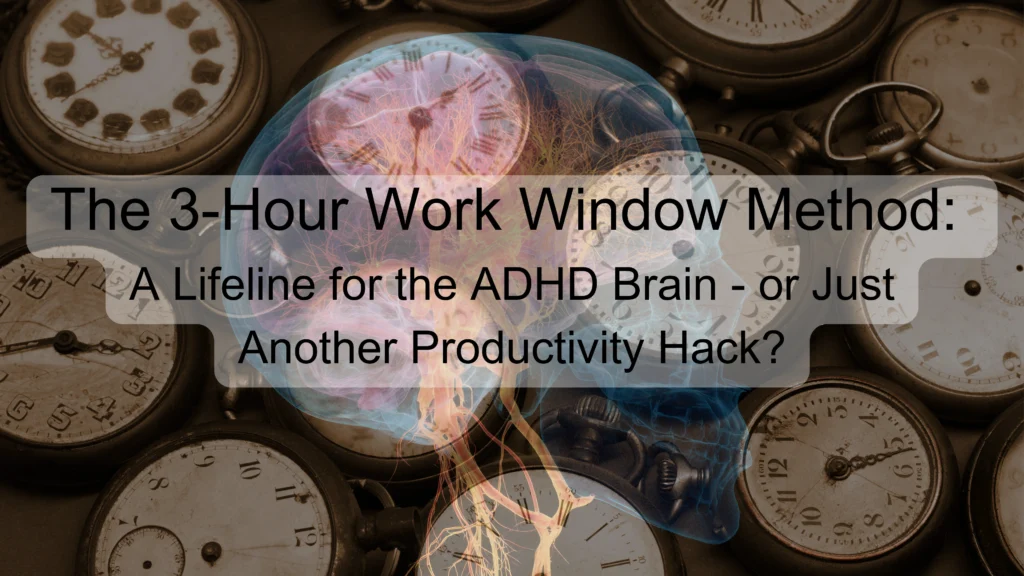The 3-Hour Work Window Method: A Lifeline for the ADHD Brain – or Just Another Productivity Hack?
One of the biggest challenges for adults with ADHD is managing time – or, more precisely, feeling time. We often experience what’s known as time blindness – an elastic sense of time that stretches and contracts depending on our focus and emotional state.
I often underestimate how long something will take or completely lose track of time when I get hyper-focused. It’s a rollercoaster of intensity and fatigue. Then I realise all the things I intended to do and forgot about!
That’s where the 3-Hour Work Window Method comes in. I discovered this straightforward, structured approach designed to work with the ADHD brain, not against it, and decided to give it a go.
SIGN UP TO MAILING LIST
What Is the 3-Hour Work Window?
The idea is beautifully simple: Instead of adhering to the traditional 8-hour workday (which is often unsustainable for ADHD minds), you work in focused 3-hour blocks, aligning your tasks with your natural energy peaks.
Each 3-hour segment is a focused creative burst, followed by genuine rest or a transition into lighter activities. Think of it as giving your brain permission to work intensely and deliberately, then recover — instead of living in a constant state of half-focus, half-fatigue.
The Pros – Why It Works So Well for ADHD Brains
- It respects your neurobiology.
ADHD brains aren’t designed for marathon focus; they excel in sprints. The 3-hour window aligns with this natural rhythm, enabling you to concentrate deeply without experiencing burnout. - It reduces overwhelm.
A full day’s to-do list can feel paralysing, but a three-hour window feels manageable — achievable. This sense of containment lowers anxiety and makes starting easier. - It prevents the hyperfocus–burnout cycle.
When you allow yourself to pause after 3 hours, you avoid the familiar crash that comes after a hyperfocus binge. The structure helps you stop before reaching exhaustion. - It builds consistency and confidence.
As you practise this method, you begin to feel the satisfaction of completing tasks regularly, which boosts motivation and self-trust — something many adults with ADHD find challenging. - It fosters a balanced life rhythm.
By incorporating short rests, reflection, or movement breaks between work segments, you create space for relationships, family, and well-being — not just productivity.
The Cons – Or, Let’s Say, the Cautions
- It can initially feel restrictive.
If you’re used to working chaotically or reacting to deadlines, the structure of a 3-hour window might seem unnatural. It takes a few weeks to adjust to the rhythm. - Transitioning between windows can be challenging. ADHD minds find task-switching difficult. Moving from focus to rest or between different tasks requires deliberate cues, such as alarms, rituals, or body movements.
- It’s not a one-size-fits-all model.
Some people have shorter attention spans and may need 90-minute intervals; others thrive on four-hour creative spurts. The key is to experiment and find your own ideal timing. - Guilt can creep in.
Many entrepreneurs or professionals with ADHD carry internalised shame about their productivity. Taking breaks may trigger guilt — “I should be doing more.”
But rest is productive when it’s part of a sustainable system.
SIGN UP TO MAILING LIST
How to Make the 3-Hour Window Work for You
Begin with one window each day. Treat it as your sacred focus period. Turn off notifications, close unnecessary tabs, and inform others that you’re in your “flow zone.” Use timers, background music, or ambient sounds to help focus your attention.
After the window ends, celebrate finishing, stretch, drink water, breathe deeply, and step back. Then, if you feel up to it, start another, or deliberately choose not to. The decision is yours.
Final Thoughts
I have used the method on and off on several occasions, but then forgot that I was using it. I really like it when I use it and just need to use it consistently for my neuroplasticity to develop new neural pathways.
Here’s what I know:
The 3-Hour Work Window isn’t about working less – it’s about working smarter, with greater self-respect.
As Carl Honoré wrote in In Praise of Slow,
“By slowing down at the right moments, we become more efficient, creative, and connected.”
For ADHD entrepreneurs and professionals, that’s the key: slowing down enough to let your brilliance breathe. It really does make a difference. I often follow up my work sprint with a walk in the park as a kind of reward for my productivity. That becomes part of my self care and work/life balance.
When you stop battling your mind and start working with it, life begins to flow again – with focus, freedom, and fulfilment.
If you would like to explore coaching with me on this topic, email grace@gracechatting.com or explore my Coaching Packages here

